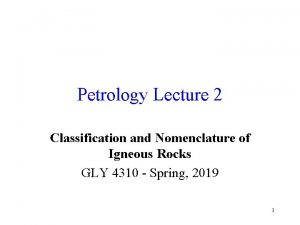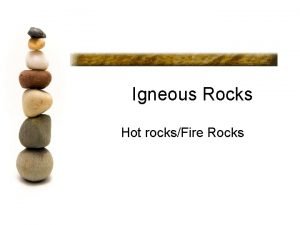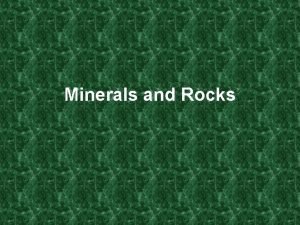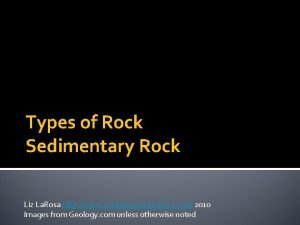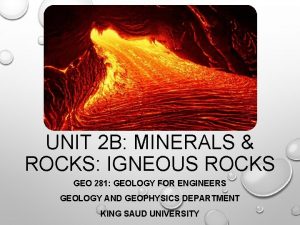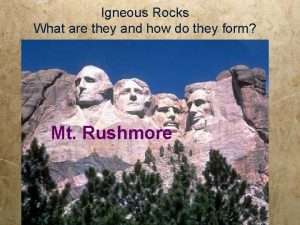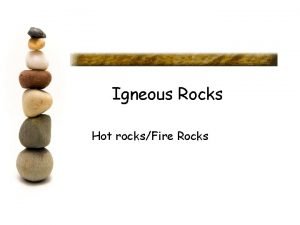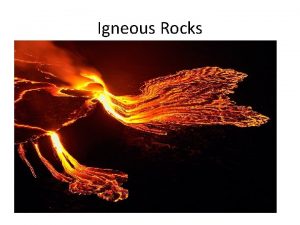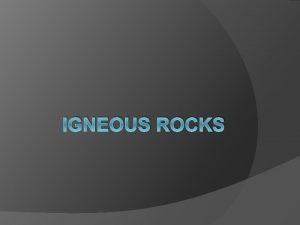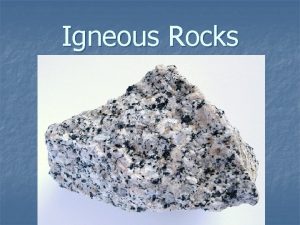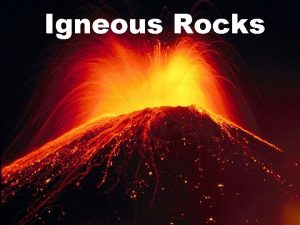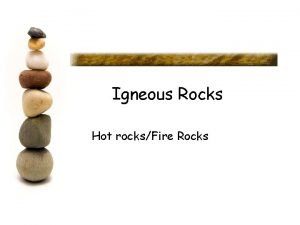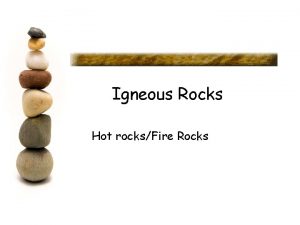Identifying Common Igneous Rocks Igneous rocks are composed













- Slides: 13

Identifying Common Igneous Rocks Igneous rocks are composed of a variety of minerals that contribute important classification characteristics. Click here to see two classification methods

Step 1: Describe the rock’s texture Coarse Fine Step 2: Describe the rock’s color. Light Color Intermediate Color Dark Color Step 3: Where does this place you on the chart and what is the name of this igneous rock? Click on a name in the chart to find out if you are correct. Back Next

Step 1: Describe the rock’s texture Coarse Fine Step 2: Describe the rock’s color. Light Color Intermediate Color Dark Color Step 3: Where does this place you on the chart and what is the name of this igneous rock? Click on the name to find out if you are correct. Back Next

Step 1: Describe the rock’s texture Coarse Fine Step 2: Describe the rock’s color. Light Color Intermediate Color Dark Color Step 3: Where does this place you on the chart and what is the name of this igneous rock? Click on the name to find out if you are correct. Back Next

Step 1: Describe the rock’s texture Coarse Fine Step 2: Describe the rock’s color. Light Color Intermediate Color Dark Color Step 3: Where does this place you on the chart and what is the name of this igneous rock? Click on the name to find out if you are correct. Back Next

Step 1: Describe the rock’s texture Coarse Fine Step 2: Describe the rock’s color. Light Color Intermediate Color Dark Color Step 3: Where does this place you on the chart and what is the name of this igneous rock? Click on the name to find out if you are correct Back Next

Step 1: Describe the rock’s texture Large Crystals Small Crystals Step 2: Describe the rock’s color. Light Color Intermediate Color Dark Color Step 3: This rock is known for its salt and pepper appearance. Step 4: Where does this place you on the chart and what is the name of this igneous rock? Click on the name to find out if you are correct Back Next

These three igneous rocks are not on the texture vs. color chart. Can you pick out the characteristic that helps identify each one? This is light colored PUMICE. Which term best describes its texture? Vesicular Or Glassy Vesicular? Click here This is dark colored SCORIA. Which term best describes its texture? Vesicular Or Glassy Pumice and scoria are both full of empty gas voids. In pumice, the tiny voids are not well interconnected. The larger ones in scoria are interconnected. Is this Pumice enough of a hint to figure out pumice’s unique characteristic? See answer! floats on water! This is black OBSIDIAN. Which term best describes its texture? Vesicular Or Glassy Back Next

Igneous Rock Texture, Cooling Rate, and Origin Location In most cases, the texture of an igneous rock provides a clue that suggests how quickly, in relative terms of fast vs. slow, the molten magma or lava took to cool into solid rock. The concept is really simple: The slower the molten material cooled, the coarser the texture of the igneous rock. An extension of this idea is that molten magma or lava will cool differently depending on physical location. Lava, molten rock expelled onto Earth’s surface, will cool relatively quickly. On the other hand, magma, molten rock trapped inside Earth, will cool much more slowly. Can you develop a simple conceptual model that explains this phenomena? Click here to check your idea Think you understand? Complete the following sentence by clicking on the correct response. magma Basalt, a fine grained igneous rock formed as a molten mass of on Earth’s surface. cooled lava inside Earth. You should be able to construct a similar sentence for the coarse grained igneous rocks, such as granite. Back Next

Now for the really good stuff!! The mineral composition and chemistry of rhyolite and granite are the same! The only difference is their texture due to cooling rate. Which is the intrusive version? Click a photograph below to confirm your answer Granite Rhyolite The mineral composition and chemistry of gabbro and basalt are the same. The only difference is their cooling rate. Which is the extrusive version? Click a photograph below to confirm your answer. Gabbro Basalt Obsidian is a well known volcanic rock. Its texture is fine grained and looks like glass. It also breaks with the same kind of unique conchoidal fracture pattern that glass does. Is obsidian intrusive or extrusive? What event(s) had to transpire to turn molten rock into a hunk of black glass? And, what’s conchoidal? Time for you to do some research on your own. Obsidian Back Next

Almost done! Apply your knowledge of igneous rocks. 1. Print the next page. 2. Name the five igneous rocks. Write the name of the rock beside it on your printed page. 3. Ask your teacher to verify your decision. 4. Be prepared to explain the process you used to identify each rock. 5. The pictures are new. Don’t memorize images of rocks, use the process of characteristics. 6. The last page is an expanded version of the igneous rock chart. It may be of help. Back Next

This is ___________________ This is __________ Back Next

Back
 Igneous rock sedimentary rock metamorphic rock
Igneous rock sedimentary rock metamorphic rock Compaction and cementation
Compaction and cementation Mikael ferm
Mikael ferm Adjective
Adjective Adjective clause identification
Adjective clause identification Identify the essential
Identify the essential Iugs classification of igneous rocks
Iugs classification of igneous rocks Igneous rocks
Igneous rocks Venn diagram of intrusive and extrusive igneous rocks
Venn diagram of intrusive and extrusive igneous rocks Types of rocks song
Types of rocks song Concept map for igneous rocks
Concept map for igneous rocks Characteristics of igneous rocks
Characteristics of igneous rocks Uses of igneous rocks
Uses of igneous rocks Pumice crystal size
Pumice crystal size






